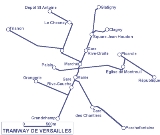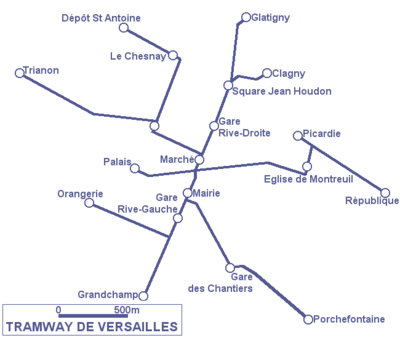
Tramway de Versailles
Encyclopedia
The Tramway de Versailles or Tramway Versaillais was a standard gauge
tram
way system serving the French
city of Versailles
.
__noTOC__
 The first lines opened in 1896 and served:
The first lines opened in 1896 and served:
The first modernisation was the opening of a steam tram between Versailles and Saint-Cyr
on 20 November 1889. The second happened in October 1895 when the SVTE (Société Versaillaise de Tramways électriques) took over the network, electrified it and purchased 29 electric tramways from the Postel-Vinay works.
The network went from three to six lines and served:
In 1907, line C was extended to Porchefontaine
and line D to République.
During the 1950s the network was formed only of lines A, B, C and E. It was seriously amputated at the dawn of World War II
and closed on 3 March 1957 during a glorious celebration with 200 000 inhabitants, the mayor of Versailles, Maurice Chevalier
and the baptism
of the replacing bus
es.
The tramcars received their definite livery in the 1940s and were painted in blue and light grey.
thanks to contributions by amateurs.
Standard gauge
The standard gauge is a widely-used track gauge . Approximately 60% of the world's existing railway lines are built to this gauge...
tram
Tram
A tram is a passenger rail vehicle which runs on tracks along public urban streets and also sometimes on separate rights of way. It may also run between cities and/or towns , and/or partially grade separated even in the cities...
way system serving the French
France
The French Republic , The French Republic , The French Republic , (commonly known as France , is a unitary semi-presidential republic in Western Europe with several overseas territories and islands located on other continents and in the Indian, Pacific, and Atlantic oceans. Metropolitan France...
city of Versailles
Versailles
Versailles , a city renowned for its château, the Palace of Versailles, was the de facto capital of the kingdom of France for over a century, from 1682 to 1789. It is now a wealthy suburb of Paris and remains an important administrative and judicial centre...
.
__noTOC__

- Square Duplessis - Grandchamps
- la Rive Droite - Sénat
- la Rive Gauche - Chambre Députés.
The first modernisation was the opening of a steam tram between Versailles and Saint-Cyr
Saint-Cyr
The toponym Saint-Cyr refers to the popular child-saint Saint Quiricus , whose following was strong in France because relics were brought back from Antioch by the 4th-century Bishop Saint Amator of Auxerre...
on 20 November 1889. The second happened in October 1895 when the SVTE (Société Versaillaise de Tramways électriques) took over the network, electrified it and purchased 29 electric tramways from the Postel-Vinay works.
The network went from three to six lines and served:
- Line A: Glatigny - Granchamp
- Line B: Clagny - Orangerie
- Line C: Le Chesnay - Chantiers
- Line D: Square Jean Houdon - Montreuil
- Line E: Rive Droite - Trianon
- Line F: Rive Gauche - St Cyr
In 1907, line C was extended to Porchefontaine
Porchefontaine
Porchefontaine is a neighborhood which is located into the south-east of Versailles, in Yvelines department of France.It was a working class neighborhood with mainly houses.Since the 1970s, the working class has been replaced by white collar workers....
and line D to République.
During the 1950s the network was formed only of lines A, B, C and E. It was seriously amputated at the dawn of World War II
World War II
World War II, or the Second World War , was a global conflict lasting from 1939 to 1945, involving most of the world's nations—including all of the great powers—eventually forming two opposing military alliances: the Allies and the Axis...
and closed on 3 March 1957 during a glorious celebration with 200 000 inhabitants, the mayor of Versailles, Maurice Chevalier
Maurice Chevalier
Maurice Auguste Chevalier was a French actor, singer, entertainer and a noted Sprechgesang performer. He is perhaps best known for his signature songs, including Louise, Mimi, Valentine, and Thank Heaven for Little Girls and for his films including The Love Parade and The Big Pond...
and the baptism
Baptism
In Christianity, baptism is for the majority the rite of admission , almost invariably with the use of water, into the Christian Church generally and also membership of a particular church tradition...
of the replacing bus
Bus
A bus is a road vehicle designed to carry passengers. Buses can have a capacity as high as 300 passengers. The most common type of bus is the single-decker bus, with larger loads carried by double-decker buses and articulated buses, and smaller loads carried by midibuses and minibuses; coaches are...
es.
Rolling stock
- Horse drawn trams.
- 29 electric Postel-Vinay tramcars (1896), transformed in 1922 and renumbered 1 to 9. They were open-ended and painted in yellow and white. the tramcars were staffed by two men, a wattman, who drove the trams, and a ticket inspector, who was in charge of collecting fares, the trolley pole and point levers. The tramcars were modernised after World War IWorld War IWorld War I , which was predominantly called the World War or the Great War from its occurrence until 1939, and the First World War or World War I thereafter, was a major war centred in Europe that began on 28 July 1914 and lasted until 11 November 1918...
and their open ends closed as well as the replacing of the two motors by one more powerful. - 2 Carde double-decker tramcars (1908).
- 4 large capacity tramcars (1927), numbered 53 to 56 and capable of transporting 55 seated passengers.
- 1 modern Satramo tramcars (1930).
- 11 transformed Postel-Vinay tramcars in 1933, numbered 10 to 20.
The tramcars received their definite livery in the 1940s and were painted in blue and light grey.
Tramcars in preservation
Tramcar n°1 is preserved at the AMTUIR in Saint-Mandé. It was the first tram "rescued" by the museum on 16 March 1957. It was acquired by the museum from EDFÉlectricité de France
Électricité de France S.A. is the second largest French utility company. Headquartered in Paris, France, with €65.2 billion in revenues in 2010, EDF operates a diverse portfolio of 120,000+ megawatts of generation capacity in Europe, Latin America, Asia, the Middle East and Africa.EDF is one of...
thanks to contributions by amateurs.
| Tramcar n°1 data | |
| Length | 8.12m |
| Width | 2.00m |
| Height | 3.61m |
| Gross weight | 10.2t |
| Capacity | 20/19 |
| Engine | GE 800 25hp |
| Current | by trolley |
| Truck | Postel-Vinay |
| Gauge |

